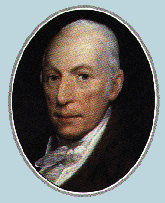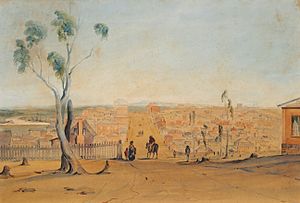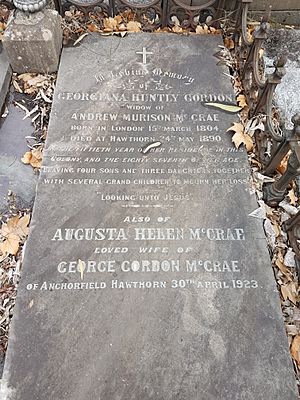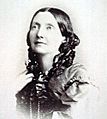Georgiana McCrae facts for kids
Quick facts for kids
Georgiana McCrae
|
|
|---|---|
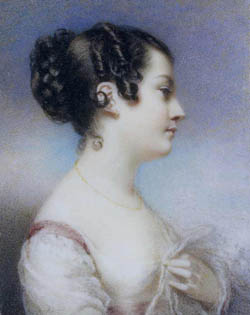 |
|
| Born | 15 March 1804 London, England
|
| Died | 24 May 1890 (aged 86) |
| Spouse(s) | Andrew McCrae |
Georgiana Huntly McCrae (born March 15, 1804 – died May 24, 1890) was a talented English-Australian painter and diarist. She is known for her beautiful artworks and for keeping detailed journals about her life.
Contents
Early Life and Education
Georgiana was born in London, England. Her father was George Gordon, the Marquess of Huntly, who later became the 5th Duke of Gordon. Her mother was Jane Graham. Even though her father publicly said she was his daughter, he wasn't very involved in her daily life. He did, however, help support her mother financially.
Georgiana spent some of her early childhood in Scotland. By late 1806, she was back in London. She was baptized there on October 6, 1806.
Around 1809, Georgiana and her mother moved to Somers Town. This area of London had many French people who had fled the French Revolution. Georgiana started school at a convent school where all lessons were taught in French. This meant she learned to speak two languages from a young age! However, she didn't stay there long. People paying for her education worried about the school's influences. She was then sent to another school in Fulham for a year, before being taught at home.
Her first art teacher was Louis Mauleon. He was a civilian prisoner of war who made toys to earn a living. For two years, he visited her home every morning. He taught her many artistic skills, like how to make her own charcoal sticks for drawing.
Developing Her Artistic Talent
In 1813, Georgiana's aunt, Margaret Graham, passed away. She left money for Georgiana to use later, perhaps to buy her own home. After being ill, Georgiana went to a new boarding school but soon returned home for good. By 1814, she lived near Regents Park in London. An elderly French priest, Abbé Huteau, taught her general subjects until 1820.
Georgiana worked very hard on her painting and drawing. Her biographer, Brenda Niall, thinks this was because Georgiana might have needed to earn her own living as a portrait painter. However, it was hard for women artists back then. The Royal Academy, a famous art school, did not accept women students. Georgiana did attend the studio of a landscape painter named John Varley. But she was best at painting portraits of people. It was also difficult for women to find people to buy their art without a man to help them.
Even though women couldn't study at the Royal Academy, they could show their art there. When Georgiana was just 12 years old, one of her paintings was shown in 1816. More of her pictures were shown in the years that followed. In 1820, she won a silver medal from the Society of Arts. This was for her portrait of her grandfather, Alexander Gordon, 4th Duke of Gordon. A year later, she won another award, the Society's silver palette, for her painting called Portrait of a French lady.
Life in Scotland
Around this time, Georgiana's mother had an accident and was unwell for the rest of her life. Georgiana then went to live at Gordon Castle in Scotland. This was the home of her grandfather, Alexander, the 4th Duke of Gordon. She lived in a grand place with many famous paintings.
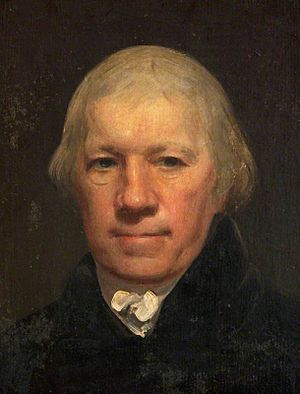
Her grandfather passed away in 1827. Georgiana, then 23, moved to live with her father, who was now the 5th Duke of Gordon, and his wife Elizabeth.
When it was time for Georgiana to find a husband, there were a few choices. Andrew McCrae was a lawyer and a distant relative. There was also Major McDonald and Peter Charles Gordon (Perico). Georgiana's diary shows she liked Perico best. But the Duchess Elizabeth did not approve because he was Catholic.
In 1829, Georgiana moved to Edinburgh to continue her career as a portrait painter. She hoped to become famous through her art. She focused on painting women and children, especially small, detailed pictures called miniatures. By 1830, she had earned a good amount of money from her art.
Marriage and Family Life
On January 20, 1830, Andrew McCrae asked Georgiana to marry him, and she accepted. They were married in Scotland in September that year. For the next ten years, they lived in both London and Edinburgh. Their first child, Elizabeth, was born in 1831. Then came George (1833), William (1835), and Alexander (1836). All their children were born in Edinburgh.
This time also brought sadness. Their daughter Elizabeth died in 1834. Georgiana's father passed away in 1836, and her mother in 1838. The family also faced money problems. Andrew McCrae's law career wasn't doing well.
Many of Andrew's family members decided to move to Australia. In November 1838, Andrew and Georgiana planned to sail to Sydney. But Georgiana's fourth son, Farquhar, was born early, so she couldn't go with Andrew. Georgiana and the children faced illnesses, which delayed their journey. Meanwhile, Andrew struggled to start his life in Sydney. He later moved to the new town of Melbourne and began working as a lawyer. Finally, in October 1840, Georgiana and her four children boarded a ship called the Argyle to join her husband in Australia.
Life in Melbourne
After a four-month journey, Georgiana and her children arrived in Hobson's Bay, near Melbourne, on March 1, 1841. The family moved into a rented house in Melbourne. Georgiana quickly made friends, including Sophie La Trobe, whose husband was the government leader. Georgiana was busy caring for her four sons, taking them on long walks, and painting portraits for friends.
Andrew McCrae borrowed money to buy land near the Yarra River and build a house. Georgiana designed the house's layout. They called it Mayfield and moved there in February 1842. It was a lovely place for their boys. A Scottish immigrant named John McLure also came to live with them and teach the boys.
However, the economy was struggling, and by 1843, the McCrae family faced money problems. They couldn't pay back their loan, so Mayfield had to be sold. Georgiana wanted to return to Britain, but they didn't have enough money. Andrew then found a new opportunity: a large piece of land for farming at Arthur's Seat. The birth of their seventh child, Margaret, in June 1844, delayed their move. In June 1845, Georgiana and Andrew finally sailed to their new home.
Living at Arthur's Seat
The land Andrew chose at Arthur's Seat was not perfect for raising cattle. But it was a beautiful spot. Like at Mayfield, the house wasn't finished when Georgiana arrived. Her three older boys had been living there since January with their tutor, helping to build the house.
The McCrae Homestead (which still stands today and is owned by the National Trust) was designed by Georgiana. It was built using local wood.
For the next six years, the family lived a simple life at Arthur's Seat. The area provided them with fish, game, vegetables, and wheat, so they were almost self-sufficient. It was also a great place to raise children. Georgiana had two more children there, Octavia (born 1847) and Agnes (born 1851), likely without a doctor. Georgiana became known in the area for her skill in treating small injuries and illnesses.
The family continued to have visitors, from important people like Charles and Sophie La Trobe to passing travelers. They also had friendly relationships with the local Bunurong tribe. The tribe often camped near their home at certain times of the year. Georgiana and her oldest son, George, learned many native words. She also painted two members of the tribe, Benbenjie and Eliza. Her biographer noted that these portraits showed them kindly, avoiding common unfair ideas about native people at the time.
The McCraes couldn't make enough money from the land, so they had to leave Arthur's Seat in 1851. This was very hard for Georgiana, who had put a lot of effort into their home and garden. She wrote, "I must bid farewell to my Mountain Home – and forsake the garden I had formed & the trees that I planted."
The cottage they built at Arthur's Seat was later renamed McCrae Homestead. It was given to the National Trust of Victoria in 1970.
Later Years in Melbourne
Leaving Arthur's Seat caused problems in Georgiana's marriage. Andrew became a Police Magistrate in other towns. Georgiana and her four young daughters lived in a rented house in Melbourne. Except for a few weeks at the end of his life, she and Andrew did not live together again.
Melbourne had changed a lot because gold had been discovered nearby. Georgiana enjoyed meeting smart people who brought new ideas about art and literature to Melbourne. This included famous landscape painters like Nicholas Chevalier and Eugene von Guerard. In 1856, she met Louisa Anne Meredith, a woman who was also a painter, poet, and writer. They became good friends.
Despite the exciting art scene in Melbourne, Georgiana didn't do much of her own painting for about 20 years. She did paint a portrait of Louisa Anne Meredith and two studies of another friend, Edith Howitt. In 1857, she showed her work at an art exhibition and received praise for her talent. Some think the challenges in her life and marriage made it hard for her to be creative.
In January 1864, the Duchess Elizabeth passed away. Georgiana had hoped to receive some money from her father's will, but she was left nothing. This also limited her sons' chances to succeed in Australia. Georgiana dealt with her anger by writing down her memories of Gordon Castle. This might have been her way of remembering her identity as the Duke of Gordon's daughter. She also copied her old journals, perhaps changing some parts or adding new details. Around this time, she even looked into getting a divorce from Andrew, but the law made it too difficult. Instead, when Andrew retired in 1867, he left for Britain and stayed away for seven years.
Final Years
Georgiana lived with her son George in the eastern part of Melbourne. She wrote many letters, and she was very good at it. Her letters showed her sharp observations and clever way with words.
Her husband, Andrew, returned to Melbourne in April 1874. He was very ill and died in July that year. He lived with George and Georgiana for those last few weeks, which suggests they made up. However, he left no money or will. You can see a photograph of him later in life here: Andrew Murison McCrae.
In her last years, Georgiana moved between her daughters' homes. She sometimes traveled to Cape Schanck, where she painted and spent time with her friend Edith Howitt. She remained mentally sharp but could be irritable. She also had health problems, like a bad hip. Feeling her life was ending, she made her will on May 6, 1890. She passed away on May 24, 1890, at the age of 86, surrounded by almost all her family. She was buried next to her husband at Boroondara Cemetery.
Georgiana faced many challenges in her life. These included being born outside of marriage, marrying someone who wasn't her first choice, and moving to Australia, where she often had to leave homes she loved. Despite these difficulties, her home was a welcoming place for other artists and thinkers. She showed great courage, a strong personality, and amazing ability throughout her life.
Images for kids


